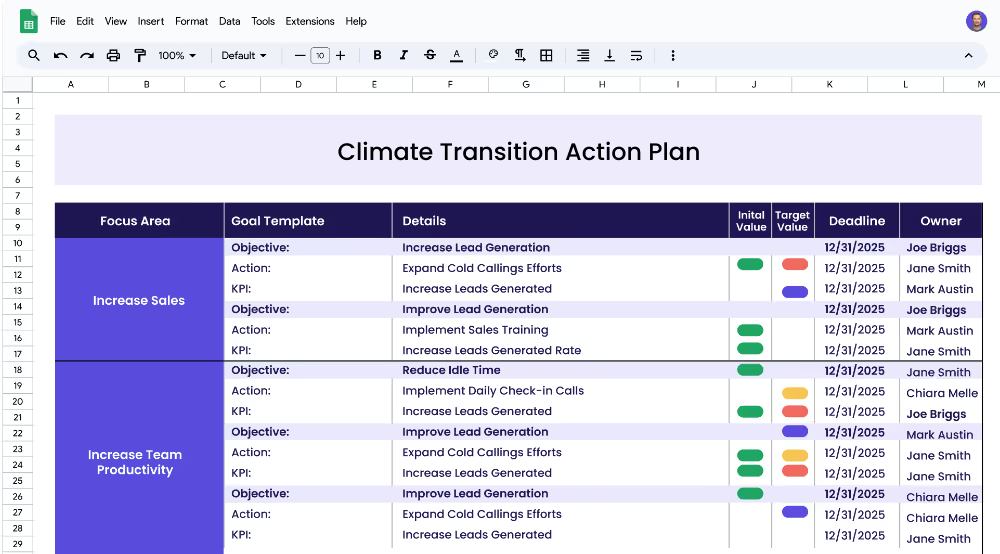A Climate Transition Action Plan is an organized approach to help organizations transition to a low-carbon and climate-resilient economy. It outlines goals and strategies to facilitate mitigation, adaptation, and sustainability. The plan helps organizations define their focus areas, set objectives, identify projects and measurable targets (KPIs), and track progress. This template is designed to help businesses create the action plan most suitable for their needs.
Each focus area has its own objectives, projects, and KPIs to ensure that the strategy is comprehensive and effective.
The Climate Transition Action Plan template is designed for all organizations, regardless of size, industry, or stage of development, who are looking to reduce their environmental footprint and promote sustainable development. This template provides a framework for organizations to create an action plan to facilitate the transition to a low-carbon and climate-resilient economy.
Focus areas are the main categories of work that your organization will be targeting. Examples of focus areas may include Climate Mitigation, Climate Adaptation, and Sustainability. Each of these focus areas will encompass a set of objectives, actions, and KPIs. Examples of strategic focus areas that could fall under a Climate Transition Action Plan could be: Climate Mitigation, Climate Adaptation, and Sustainability.
Objectives are the goals that your organization will strive to achieve within its focus areas. It's important to define SMART objectives (specific, measurable, attainable, relevant, and time-bound) that will help guide your organization's strategies and measure progress. Examples of some objectives for the focus area of Climate Mitigation could be: Reduce Carbon Footprint, and Increase Renewable Energy Use.
KPIs are the measurable targets that will be used to track progress towards the objectives. KPIs must be quantifiable, so they should be metrics with clear initial and target values, such as a decrease in average energy consumption or an increase in solar energy usage. An example of a KPI for the focus area of Climate Mitigation could be: Decrease avg energy consumption from 2.2 KWh to 1.2 KWh.
Projects are the strategies and initiatives that will be used to achieve the KPIs. Examples of projects include increasing energy efficiency, increasing renewable energy use, increasing stormwater management, and increasing flood defense infrastructure.
If you’re looking to drive your Climate Transition Action Plan forward and achieve results more efficiently, Cascade Strategy Execution Software is your ideal solution. Unlike traditional methods such as spreadsheets, Cascade offers a dynamic and integrated platform for real-time updates, centralized collaboration, and automated reporting. These features make it effortlessly easy for your team to stay aligned, adapt swiftly to any change, and track the progress without hassle. Sign-up for free or book a demo with one of our strategy experts today and experience a new level of strategic execution.


